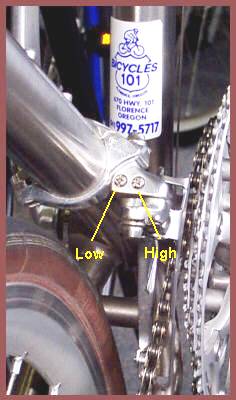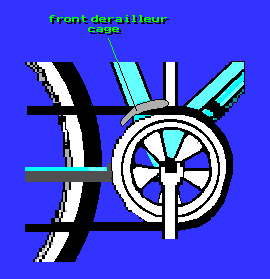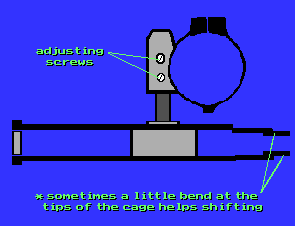"Save Big With Bicycle Discount Coupon Codes"
Bicycle Tune-Up Step 8 - Adjust The Front Derailleur
The front derailleur is adjusted like the rear one - the principles are the same. Look closely to find which limit screw does what since their positions vary on different models of front derailleurs.
1. Make sure the front derailleur cage is parallel to and above the largest front sprocket by only about three millimeters (1/8 inch).
2. With the rear derailleur in high (smallest sprocket), tighten the front derailleur high gear screw until you cannot shift into high gear (large front sprocket). Back out the screw while turning the pedals and operating the shifter until you just get a clean shift every time.
3. Repeat this procedure for shifting down to the smallest front sprocket, but with the rear derailleur engaged in low gear.
4. Check all combinations of front and rear gear selection. You may have to compromise the adjustments a little to get a clean shift in all cases.

5. Because the chainwheels (front sprockets) are probably not perfectly flat, try all combinations of shifting when the pedals are at varying angles of rotation.

Sometimes front derailleurs will require a little bending to get proper function. If the chain sometimes falls off even though the adjustment seems correct, try bending the front edge of the derailleur cage in a little bit.

Top view of a front derailleur
If the derailleur is reluctant to engage high or low gear, the cable may need adjustment. Shift toward the largest sprocket, pushing the shifter all the way in its travel. Loosen the cable inner wire anchor bolt, pull the slack out of the cable and retighten.
If that doesn't work, the cable may be sticky or rusted, and should be cleaned or replaced.
If you have done everything right, but the chain still falls off occasionally, or the derailleur is slow to shift, consider the following points:
The chainwheels may be bent. If so, you'll see them waver as you turn the pedals. You can simply bend them back into plane. Do this carefully with a rubber hammer.
One or more teeth of the chainwheels may be bent. You may be able to straighten a bent tooth by grabbing it with an adjustable wrench.
The chain or the chainwheels may be worn out.
The chain or the chainwheels may be of low quality. This is common, and the usual cures are to ignore the problem, or spend money. Keep in mind that to get the performance we do get with bicycles, the engineering is a compromise between reasonable weight, features, and cost. If you want perfection, you've got to pay the price. The price isn't always money. Even if you spent a million dollars for the best bicycle money could buy, you'd still find some aspects of your machine which would be less than satisfactory. Hey, it's either settle, or walk!
Skipping problems are not related to the derailleurs. If your bike has a skip when pedaling hard, check the skip's frequency. If it is once for every revolution of the chain, there is probably a stiff link. Try lubricating and flexing the chain laterally. If the skip is once per each revolution of the front or rear sprockets, look for damage or build up of dirt on the offending sprocket. If the skip frequency is random, the chain and freewheel are probably worn out, requiring replacement for best performance.
The following situations indicate that the cable needs replacing:
1. The front derailleur easily engages high gears (large sprockets) but hesitates to engage the smallest sprocket, or doesn't engage it at all. This is even after the low gear adjustment has been set, as in the above paragraphs.
2. The shifter is very hard to move. Make sure that the reason is not just that the shifter friction adjustment has been set too tight. Some shifters have a large screw or wingnut that can be adjusted. When too loose, the shifter slips back into high gears when you hit bumps. When too tight, the shifter is hard to move.
3. If you see broken strands on a cable inner wire, it should be replaced. A cable with just one broken strand is less than half as strong as one that's intact.
Click here for cable maintenance and replacement information
![]()
3 Things You Need To KnowBefore You Buy
Back - Rear Derailleur Adjustment
Tell a Friend About BikeWebSite
Please feel free to link your web pages to www.bikewebsite.com.
![]()
Copyright © 1991-2014, bikewebsite.com